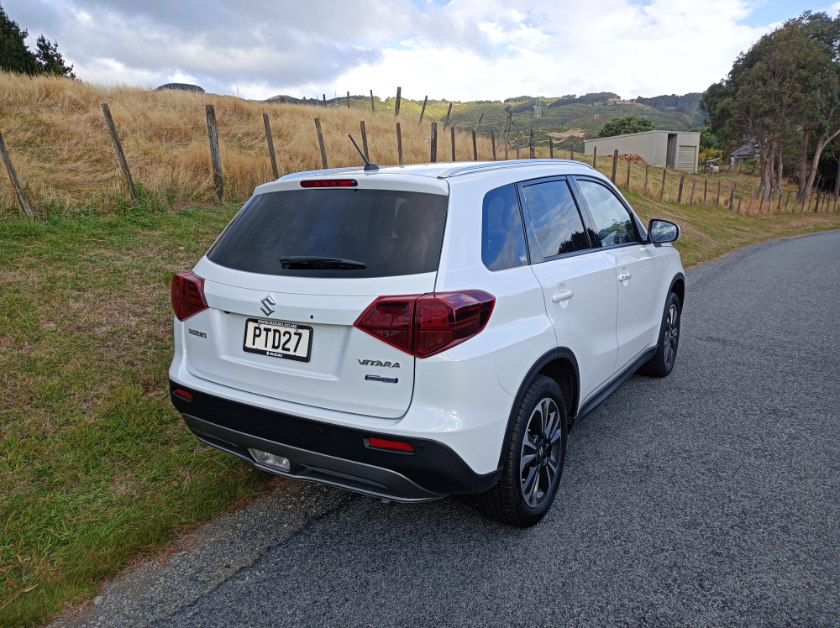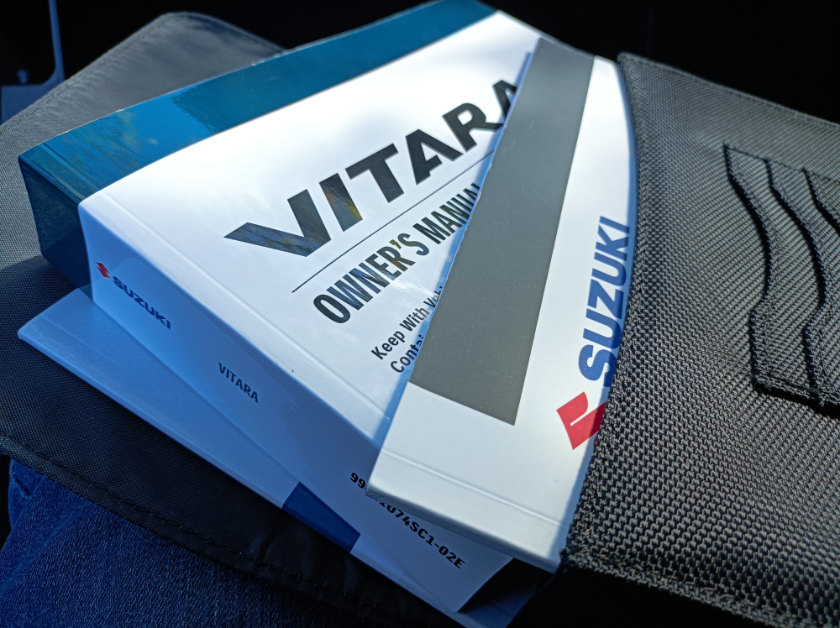
Living
The Suzuki Vitara JLX Hybrid is an honest vehicle that remains a competitive, well priced entry for those in the market for a B-segment crossover, writes Jack Yan
Photographed by the author





It’s been many years since Lucire profiled the 2004 Swift—a car we liked and rightly predicted would do very well—so when the opportunity came to try the Vitara Hybrid, a model that joined the range in 2022, our curiosity was piqued.
Suzuki does certain things exceptionally well. There’s no doubt, for starters, that they are experts in light cars. They’re so good that in Japan, they do OEM deals with a lot of the other players. Back when GM was a global force, Suzuki created some of their small cars, including two generations of the Holden Barina. They’re the market leader in places that demand smaller vehicles, like India and Pakistan.
Secondly, their vehicles are never exactly of the time we are in: they transcend the usual automotive fads. They probably have to, owing to their very long product lives, as Volvo once contended with: that 2004 Swift continued to be made in Pakistan till 2021. Look at any Swift that came out since 2004: styling-wise, they all still appear modern. Not many car makers do this well.
Look back through history and Suzuki breaks industry monotony many times. I still remember a colleague—a young Sloane Ranger—buying one of the first 1988 Vitaras (Escudo on the home market). No one was really doing stylish cars on separate chassis, but here was Suzuki doing what it was good at, and clothing it in a body that would appeal to female customers. They marketed it as a soft-roader but it was actually quite rugged—and that kicked off a profitable model line that continues to this day. It was what pushed usually safe Toyota into creating the RAV4 in 1994, which, like all copies, never looked as good.
And that 1988 Vitara stayed in production till 2013 in Ecuador, and spun off the curious rear-drive X-90 two-door “coupé”, which was misunderstood. But at least Suzuki was trying something different, as it did with the Giugiaro-designed Fronte coupé back in 1971 or the Cappuccino convertible 20 years later. Both are cult cars now. If we were some other title with a ‘cool wall’, there’d be Suzukis on it.
The Vitara Hybrid traces its roots to the 2015 generation which first appeared at the Paris show that year, built at its Esztgergom, Hungary factory. Europeans were flocking to B-segment crossovers like the Nissan Juke and Renault Captur, and Suzuki responded. While the Grand Vitara that appeared 10 years before was a monocoque with a ladder frame welded to the floorpan, this Vitara is a monocoque. In other words, it’s more car-like than any Vitara before, making it a perfect rival to the new players encroaching on to the territory that Suzuki created.
Suzuki didn’t soften the lines too much: it has way too much heritage for that. Suzuki off-roaders have been mud-plugging for years, and buyers of this size of crossover want something that looks as though it could survive the urban jungle. The original Juke was comical and bought by those who wanted cute; the Captur (or others like the Honda HR-V or Peugeot 2008) might have struck buyers as too car-like. In 2019, Suzuki made the Vitara look even sharper with vertical chrome bars on the grille as part of a facelift. Looking at it in 2024, it’s remarkable how well it’s aged, testament to Suzuki’s not-quite-of-the-time design. It doesn’t look precious like a jewel, but it’s inoffensive. The polished alloys also lift the Vitara’s looks.
Not having even trialled a Suzuki for years, I expected a utilitarian interior, with the company channelling old SJ off-roaders from the 1980s, but what greeted me was remarkably pleasant. Stepping into our front-drive JLX-spec test car (retailing for NZ$41,990), there’s well designed instrumentation with enough brightwork to even look, dare I say it, premium. Typographically, the dials are clearly marked, and they’re analogue, which might be a welcome change for many buyers. It’s not in the sort of dated Japanese typeface, either, something which plagued many of that country’s cars, just as stock Android fonts bring Chinese car displays down a notch today. There’s a central display where you can cycle through the pitch of the vehicle and a fuel economy reading, but I opted to show when the battery was being charged through regenerative braking. As a mild hybrid system, Wellington’s Ngauranga Gorge and some careful, light-footed driving can charge it up. It’s incredibly practical and it works well.
Also contrary to Japanese practice is the indicator stalk being on the left: having bought European myself my adult life, there was no adjustment needed, plus I had expected that since Ford shifted to the left with the Mk IV Cortina here, this would have become the norm. Unlike the UK, it didn’t.
Layout-wise, and ergonomically, this was a pleasant place to be, with the air vents at the top of the dashboard, remarkably easy to use music and cruise control switches, and a pleasant-feeling steering wheel. The 7 in infotainment screen is reasonably sharp and again, simple to operate. Occasionally our phone’s music wouldn’t come through the Bluetooth but there’s an easy fix: cycle through the radio modes and go back to Bluetooth, and it’s on again. (We’ve seen far worse and they involve stopping the car.) You’re supported by excellent (this isn’t hyperbole) suede seats that are soft to the touch with leather bolsters.
The only places inside that might come up for any criticism is a trace of harder plastics in the storage space in the centre console and around the automatic gear lever, and the fact that the space will not fit a modern cellphone on its side well, since they have grown in size since 2015. The shiny silver plastic effect looks dated and also betrays its origins, one of the few things that wasn’t as timeless as Suzuki’s designers may have thought.
Everything is light to the touch. The doors swing out widely with little strength; put the car into gear and it’s very eager to go. The word effortless comes to mind. Similarly, the 1·4-litre turbo petrol engine is an easy unit, though it will give you the boost when needed with the battery under hard acceleration, totalling 129 PS (95 kW). Suspension is tuned to be on the softer side, with a supple ride for urban driving, so don’t expect sports’ car handling. The six-speed auto—happily, Suzuki will still sell you a six-speed manual with a slightly lower spec, which must be a rarity in New Zealand—gives a smooth shift, and you can use the sequential gearbox and the paddles, positioned very naturally to the sides behind the steering wheel.
You sit high, with a high centre of gravity, as anyone who buys a crossover will expect. The bonus is exactly what crossover buyers want: visibility, and the Vitara has plenty. It’s not plagued with thick pillars as more “fashionable” cars are: Suzuki has kept it practical with a six-light body that you can easily see out of. This is a huge claim to make, but of all the cars we’ve had on test in almost a quarter-century, the Vitara was the easiest to park. You know exactly where each corner is, and there was never any danger of damaging the alloys. Maybe that 1,775 mm width helps: for many people who learned to drive in a 1,700 mm wide car (what the Japanese call class 5), and I’ll bet that’s a lot of us, then the Vitara seems “right-sized”. Length-wise, it’s 4,175 mm, again aiding entry into those tighter spots.
Safety features abound: the rear cross-traffic alert is sensitive—the way it should be—and there’s a blind spot monitor (though the door mirrors already have a decent field of vision and can be adjusted to eliminate the blind spots anyway). The lane-departure warning doesn’t fight your steering: it just gives you a polite audible warning and shows you in the digital display. The way I prefer it.
The boot is a decent size for the segment (375 ℓ, 710 ℓ when you fold the rear seats down), and while the wheelbase is 2,500 mm, the rear compartment was still comfortable.
Suzuki claims 5.6 ℓ/100 km (50 mpg Imperial), which is believable and achievable. We had a higher figure in the low 6s but as a test we weren’t always economical in our driving style. The car does take 95-octane petrol, but overall, we believe we were better off with the mild hybrid system and drove knowing there was a reduction in CO₂.
It’s a reasonably complete package for the price that we like for its honesty, and on paper, there’s really only one car that Suzuki should have some concerns about competitively: its own S-Cross, which cuts the Vitara closely on price and has some newer tech, even though it’s aimed a different type of customer. We haven’t sampled its sister offering, but from our two weeks with it, the Vitara Hybrid keeps Suzuki in the game competitively. •








Jack Yan is founder and publisher of Lucire.
Related articles hand-picked by our editors

Third time’s a charm?
MG has released its most compelling ZS EV yet: one with 440 km on a full charge. Jack Yan samples the latest in a theme
Photographed by the author

Škoda Karoq: being Praguematic
It’s farewell to Škoda’s very clever Yeti after eight years, and hello to the Karoq, another unusually named compact vehicle. But rather than the MPV-like philosophy of the earlier car, this one’s a crossover with SUV proportions. Does it succeed? Jack Yan takes it for a brief test
Video filmed and edited by Stuart Cowley

Remaking Trax
The Holden (née Chevrolet) Trax, related to the Opel Mokka and Buick Encore, is a more pleasing package after its facelift, writes Jack Yan
Photographed by the author